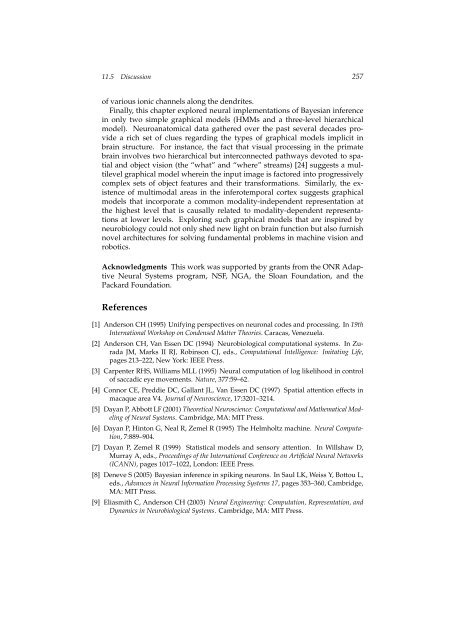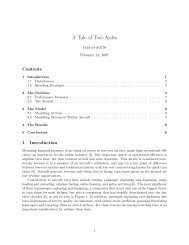Neural Models of Bayesian Belief Propagation Rajesh ... - Washington
Neural Models of Bayesian Belief Propagation Rajesh ... - Washington
Neural Models of Bayesian Belief Propagation Rajesh ... - Washington
You also want an ePaper? Increase the reach of your titles
YUMPU automatically turns print PDFs into web optimized ePapers that Google loves.
11.5 Discussion 257<br />
<strong>of</strong> various ionic channels along the dendrites.<br />
Finally, this chapter explored neural implementations <strong>of</strong> <strong>Bayesian</strong> inference<br />
in only two simple graphical models (HMMs and a three-level hierarchical<br />
model). Neuroanatomical data gathered over the past several decades provide<br />
a rich set <strong>of</strong> clues regarding the types <strong>of</strong> graphical models implicit in<br />
brain structure. For instance, the fact that visual processing in the primate<br />
brain involves two hierarchical but interconnected pathways devoted to spatial<br />
and object vision (the “what” and “where” streams) [24] suggests a multilevel<br />
graphical model wherein the input image is factored into progressively<br />
complex sets <strong>of</strong> object features and their transformations. Similarly, the existence<br />
<strong>of</strong> multimodal areas in the inferotemporal cortex suggests graphical<br />
models that incorporate a common modality-independent representation at<br />
the highest level that is causally related to modality-dependent representations<br />
at lower levels. Exploring such graphical models that are inspired by<br />
neurobiology could not only shed new light on brain function but also furnish<br />
novel architectures for solving fundamental problems in machine vision and<br />
robotics.<br />
Acknowledgments This work was supported by grants from the ONR Adaptive<br />
<strong>Neural</strong> Systems program, NSF, NGA, the Sloan Foundation, and the<br />
Packard Foundation.<br />
References<br />
[1] Anderson CH (1995) Unifying perspectives on neuronal codes and processing. In 19th<br />
International Workshop on Condensed Matter Theories. Caracas, Venezuela.<br />
[2] Anderson CH, Van Essen DC (1994) Neurobiological computational systems. In Zurada<br />
JM, Marks II RJ, Robinson CJ, eds., Computational Intelligence: Imitating Life,<br />
pages 213–222, New York: IEEE Press.<br />
[3] Carpenter RHS, Williams MLL (1995) <strong>Neural</strong> computation <strong>of</strong> log likelihood in control<br />
<strong>of</strong> saccadic eye movements. Nature, 377:59–62.<br />
[4] Connor CE, Preddie DC, Gallant JL, Van Essen DC (1997) Spatial attention effects in<br />
macaque area V4. Journal <strong>of</strong> Neuroscience, 17:3201–3214.<br />
[5] Dayan P, Abbott LF (2001) Theoretical Neuroscience: Computational and Mathematical Modeling<br />
<strong>of</strong> <strong>Neural</strong> Systems. Cambridge, MA: MIT Press.<br />
[6] Dayan P, Hinton G, Neal R, Zemel R (1995) The Helmholtz machine. <strong>Neural</strong> Computation,<br />
7:889–904.<br />
[7] Dayan P, Zemel R (1999) Statistical models and sensory attention. In Willshaw D,<br />
Murray A, eds., Proceedings <strong>of</strong> the International Conference on Artificial <strong>Neural</strong> Networks<br />
(ICANN), pages 1017–1022, London: IEEE Press.<br />
[8] Deneve S (2005) <strong>Bayesian</strong> inference in spiking neurons. In Saul LK, Weiss Y, Bottou L,<br />
eds., Advances in <strong>Neural</strong> Information Processing Systems 17, pages 353–360, Cambridge,<br />
MA: MIT Press.<br />
[9] Eliasmith C, Anderson CH (2003) <strong>Neural</strong> Engineering: Computation, Representation, and<br />
Dynamics in Neurobiological Systems. Cambridge, MA: MIT Press.
















